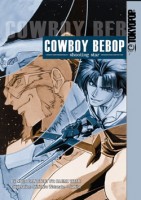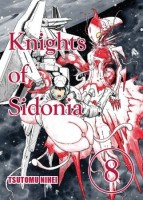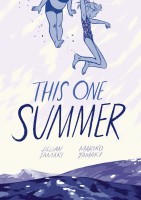My News and Reviews
The first week of the month tends to be a little slow at Experiments in Manga (at least it feels slow to me). Granted, there were still three posts last week. The Juné Manga Giveaway Winner was announced, which also includes a list of some favorite Juné manga. June’s Bookshelf Overload was posted. (My wallet thanks me that June was a little less ridiculous than the last few month have been.) And finally, the first in-depth manga review of July goes to Battle Royale: Angels’ Border. Written by the author of the original Battle Royale novel, the volume collects two side stories about the girls who try to survive the death match by banding together at a lighthouse. Angels’ Border is surprisingly romantic, but if you know anything about Battle Royale, you know that things don’t end very well for almost anyone involved.
There were plenty of things that I found to read online last week. Here’s a quick list of a few of the posts that I thought were particularly interesting: Ryan Holmberg takes a look at Hayashi Seiichi’s pop music manga, specifically focusing on “Flowering Harbour” (which is now available in English!) Moyoco Anno was interviewed by Publishers Weekly. The Beautiful World has created a Transgender Manga Masterpost. J. R. Brown has a fascinating article about what can be gleaned by paying attention to the details of ukiyo-e prints. And Justin has a rant about the state of manga in translation that is worth reading. Also, Anime Expo was last week and there were a ton of announcements. Sean has a good roundup of the licenses at A Case Suitable for Treatment.
Quick Takes
 Cowboy Bebop: Shooting Star by Cain Kuga. Of the two Cowboy Bebop manga, Shooting Star was actually the first to be released in Japan although it was the second series to be published in English. Technically, it also preceded the Cowboy Bebop anime series, which I hadn’t previously realized. However, it’s still based on the anime. Kuga was given free rein with the characters and story, which makes Shooting Star not exactly a retelling but more like an alternate version or universe. The manga isn’t as dark as the anime (though there’s humor to be found there as well), and the story is somewhat different, but the basic premise of near-future bounty hunters in space remains. Frankly, though vaguely entertaining in places, Shooting Star just isn’t as good as the anime, the action can be difficult to follow, and the slapstick is a little too silly for my taste. Shooting Star will most likely be of interest to established fans of the Cowboy Bebop anime as a curiosity more than anything else. Even though Shooting Star mostly stands on its own, people who haven’t seen the anime probably won’t get much out of it.
Cowboy Bebop: Shooting Star by Cain Kuga. Of the two Cowboy Bebop manga, Shooting Star was actually the first to be released in Japan although it was the second series to be published in English. Technically, it also preceded the Cowboy Bebop anime series, which I hadn’t previously realized. However, it’s still based on the anime. Kuga was given free rein with the characters and story, which makes Shooting Star not exactly a retelling but more like an alternate version or universe. The manga isn’t as dark as the anime (though there’s humor to be found there as well), and the story is somewhat different, but the basic premise of near-future bounty hunters in space remains. Frankly, though vaguely entertaining in places, Shooting Star just isn’t as good as the anime, the action can be difficult to follow, and the slapstick is a little too silly for my taste. Shooting Star will most likely be of interest to established fans of the Cowboy Bebop anime as a curiosity more than anything else. Even though Shooting Star mostly stands on its own, people who haven’t seen the anime probably won’t get much out of it.
 I Shall Never Return, Volumes 1-5 by Kazuna Uchida. Although the first volume of I Shall Never Return is a little shaky at the start (and parts of Ken’s stepfather’s backstory seem to be unnecessary and superfluous), overall I was actually rather impressed with this short boys’ love series. Ken comes from a broken home and is a high school dropout. His best friend Ritsuro was the only stable thing in his life but now they’re having problems, too. I Shall Never Return is filled with drama and deals with some very mature themes, such as abuse, drug use, prostitution, and rape. Terrible things happen and I was constantly waiting for something even worse. But there are also some wonderful moments of support, love, and acceptance. One of the things that I found particularly interesting about I Shall Never Return is that while it’s definitely a romance, the two leads actually spend much of the series apart from each other. Ritsuro remains in Japan while Ken travels to Singapore and then to India, trying to find a new start and become a better person. They have to deal with a long-distance relationship at the same time they’re coming to terms with their feelings for each another. It’s a believable and difficult process.
I Shall Never Return, Volumes 1-5 by Kazuna Uchida. Although the first volume of I Shall Never Return is a little shaky at the start (and parts of Ken’s stepfather’s backstory seem to be unnecessary and superfluous), overall I was actually rather impressed with this short boys’ love series. Ken comes from a broken home and is a high school dropout. His best friend Ritsuro was the only stable thing in his life but now they’re having problems, too. I Shall Never Return is filled with drama and deals with some very mature themes, such as abuse, drug use, prostitution, and rape. Terrible things happen and I was constantly waiting for something even worse. But there are also some wonderful moments of support, love, and acceptance. One of the things that I found particularly interesting about I Shall Never Return is that while it’s definitely a romance, the two leads actually spend much of the series apart from each other. Ritsuro remains in Japan while Ken travels to Singapore and then to India, trying to find a new start and become a better person. They have to deal with a long-distance relationship at the same time they’re coming to terms with their feelings for each another. It’s a believable and difficult process.
 Knights of Sidonia, Volumes 8-9 by Tsutomu Nihei. Maybe it’s because the manga’s such a bizarrely quirky series—a strange mix of science fiction, horror, and romantic comedy—but I can’t help but love Knights of Sidonia a little more with each passing volume. Nagate, Tsumugi, and Izana make a marvelous and frequently awkward family unit. And even considering that Tsumugi is a monstrous human-Gauna hybrid, she manages to be endearingly charming, sweet, and adorable. Nagate continues to be socially inept, though certainly less so, and Izana has fallen more in love with him, which has triggered physical changes. The three of them together are simply delightful, forming a not quite love triangle. In direct contrast to the humor and cheerfulness surrounding the trio, humanity’s fight for survival against the Gauna remains terrifyingly intense and death tolls continue to rise. Sometimes the battles can be a little difficult to follow, but they’re always exhilarating. There are some definite sexual overtones to Knights of Sidonia in these two volumes, which are especially apparent in the artwork, but this appropriately adds to the series’ more disconcerting atmosphere.
Knights of Sidonia, Volumes 8-9 by Tsutomu Nihei. Maybe it’s because the manga’s such a bizarrely quirky series—a strange mix of science fiction, horror, and romantic comedy—but I can’t help but love Knights of Sidonia a little more with each passing volume. Nagate, Tsumugi, and Izana make a marvelous and frequently awkward family unit. And even considering that Tsumugi is a monstrous human-Gauna hybrid, she manages to be endearingly charming, sweet, and adorable. Nagate continues to be socially inept, though certainly less so, and Izana has fallen more in love with him, which has triggered physical changes. The three of them together are simply delightful, forming a not quite love triangle. In direct contrast to the humor and cheerfulness surrounding the trio, humanity’s fight for survival against the Gauna remains terrifyingly intense and death tolls continue to rise. Sometimes the battles can be a little difficult to follow, but they’re always exhilarating. There are some definite sexual overtones to Knights of Sidonia in these two volumes, which are especially apparent in the artwork, but this appropriately adds to the series’ more disconcerting atmosphere.
 This One Summer written by Mariko Tamaki and illustrated by Jillian Tamaki. The Tamakis are a pair of cousins who previously worked together on the award-winning graphic novel Skim. This One Summer is their second collaboration. The story follows Rose over the course of her family’s summer vacation at Awago Beach where they have always rented a cottage. Rose’s mother has become more distant over the last year and can’t seem to relax, creating a significant amount of tension. There are reasons for that, though, and Rose is more perceptive than her parents might realize. But because communication has broken down between them all, it may be a while before everything will be okay again. Meanwhile, Rose spends time with her friend Windy, enjoying the beach and bingeing on horror films that they probably shouldn’t be watching at their age. In the background another drama is unfolding among the local teenagers when one of the young women discovers that she might be pregnant. It’s heartbreaking to see how insidious sexism can be. In addition to the strong and effectively layered storytelling in This One Summer, the artwork is beautiful as well.
This One Summer written by Mariko Tamaki and illustrated by Jillian Tamaki. The Tamakis are a pair of cousins who previously worked together on the award-winning graphic novel Skim. This One Summer is their second collaboration. The story follows Rose over the course of her family’s summer vacation at Awago Beach where they have always rented a cottage. Rose’s mother has become more distant over the last year and can’t seem to relax, creating a significant amount of tension. There are reasons for that, though, and Rose is more perceptive than her parents might realize. But because communication has broken down between them all, it may be a while before everything will be okay again. Meanwhile, Rose spends time with her friend Windy, enjoying the beach and bingeing on horror films that they probably shouldn’t be watching at their age. In the background another drama is unfolding among the local teenagers when one of the young women discovers that she might be pregnant. It’s heartbreaking to see how insidious sexism can be. In addition to the strong and effectively layered storytelling in This One Summer, the artwork is beautiful as well.
 Yowamushi Pedal, Episodes 15-26 directed by Osamu Nabeshima. This set of episodes finishes up the Sohoku racing club’s grueling training camp and then launches almost directly into the Inter-High race, following the competition up through the first section of the first day and ending with one heck of a dramatic plot development. Yowamushi Pedal manages to be incredibly exciting, mostly due the intensity and passion of the characters and because it includes just a touch of the ridiculous. More characters and teams are introduced, and more backstories and rivalries are revealed in this part of the series, too. The animation is sadly a bit inconsistent, sometimes impressively good while at other times lacking in finesse. Although I enjoy cycling, I’ve never really followed road racing closely. I was surprised to learn just how much teamwork can go into it; I’d always assumed it was more of an individual event. I’ve also enjoyed learning more about some of the strategies involved in racing. (And I’ll admit, now that the weather is finally decent where I live I really want to get my bike out again and hit the road! Who says watching anime can’t be good for you?)
Yowamushi Pedal, Episodes 15-26 directed by Osamu Nabeshima. This set of episodes finishes up the Sohoku racing club’s grueling training camp and then launches almost directly into the Inter-High race, following the competition up through the first section of the first day and ending with one heck of a dramatic plot development. Yowamushi Pedal manages to be incredibly exciting, mostly due the intensity and passion of the characters and because it includes just a touch of the ridiculous. More characters and teams are introduced, and more backstories and rivalries are revealed in this part of the series, too. The animation is sadly a bit inconsistent, sometimes impressively good while at other times lacking in finesse. Although I enjoy cycling, I’ve never really followed road racing closely. I was surprised to learn just how much teamwork can go into it; I’d always assumed it was more of an individual event. I’ve also enjoyed learning more about some of the strategies involved in racing. (And I’ll admit, now that the weather is finally decent where I live I really want to get my bike out again and hit the road! Who says watching anime can’t be good for you?)
